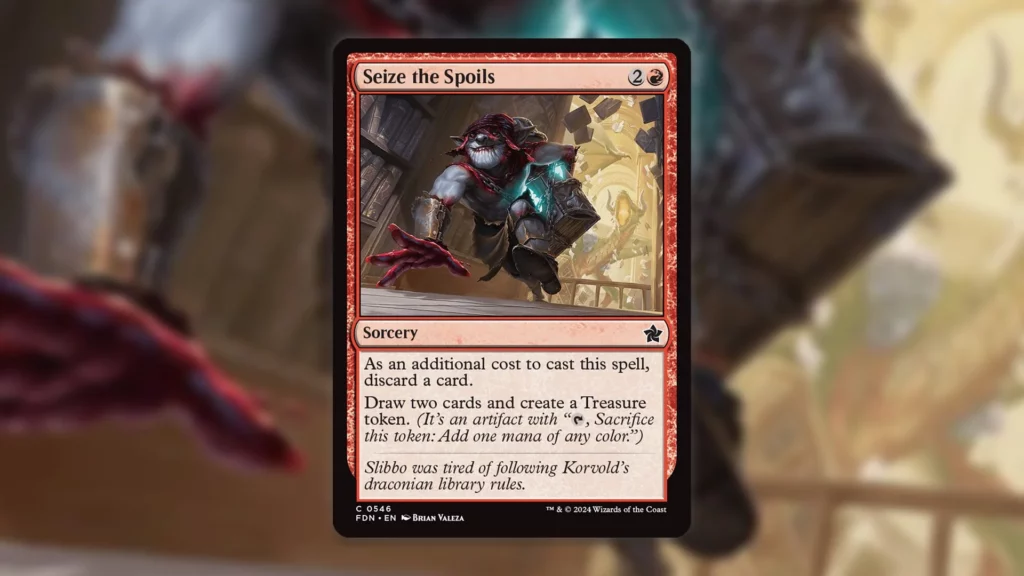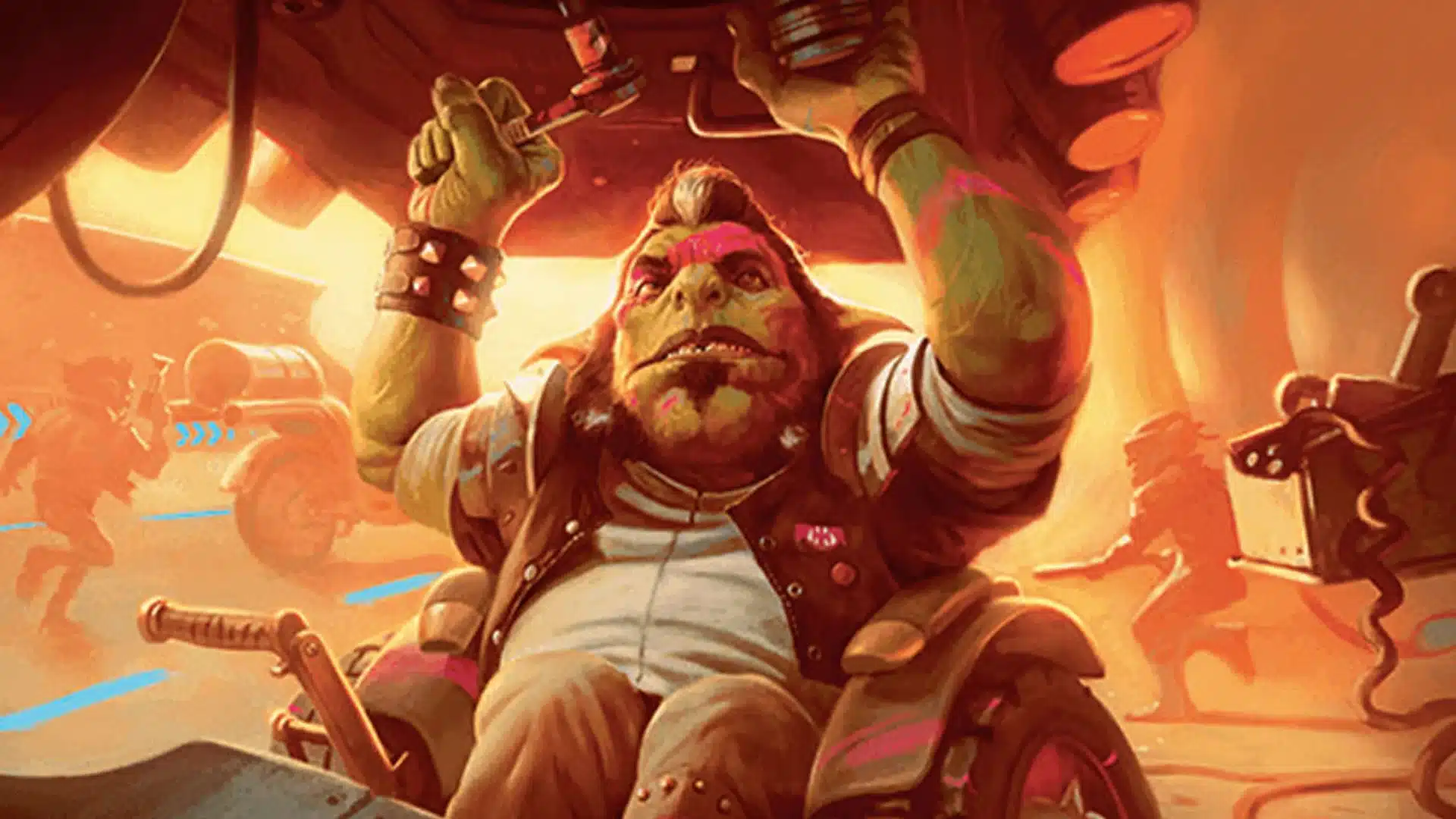Since the release of Aetherdrift, a handful of new archetypes have arisen in Standard. For instance, the powerful printing of Afterburner Expert has helped various Gruul exhaust builds make some noise in the format.
Perhaps the most intriguing of these new strategies, however, is Boros artifacts. The goal of this deck is to cheat artifact haymakers into play ahead of schedule, which was made possible by a strong duo of Aetherdrift reanimation effects. For anyone tired of playing the same old Esper self-bounce or Gruul Prowess decks that have run rampant in Standard for months, Boros artifacts has you covered.
Reanimation Effects and Haymakers

- Mana Value: 4R
- Rarity: Rare
- Card Type: Legendary Creature – Goblin Artificer
- Stats: */5
- MTG Sets: Aetherdrift
- Card Text: Daretti’s power is equal to the greatest mana value among artifacts you control.
Whenever Daretti enters or attacks, choose target artifact card in your graveyard. You may sacrifice an artifact. If you do, return the chosen card to the battlefield.
The majority of the cards in this archetype fill one of three roles. The first group of cards are the enablers. Cheap artifacts and discard outlets, which we will discuss in more detail in the next section, are super important, because they help you maximize the second collection of cards: the reanimation effects.
Both of this deck’s primary reanimation effects were printed in Aetherdrift. The most powerful of these cards is without a doubt Daretti, Rocketeer Engineer. Daretti is a very pushed card, so long as you can set it up.
Not only does it have the potential to resurrect a huge artifact, but Daretti’s a large threat in its own right. If the opponent can’t kill Daretti right away, you can continue to get a bunch of value out of its triggered ability, all while attacking for huge chunks of damage.
To help add redundancy, you’ll also find a few copies of Tune Up. Tune Up doesn’t have the upside that Daretti has but requires less set up and is more efficient.
This brings us to the third round of cards: the haymakers. These are the cards that can singlehandedly win you the game if you can put them into play early. Portal to Phyrexia and Threefold Thunderhulk are the best of the best.
Portal provides inevitability. Forcing the opponent to sacrifice three creatures usually is enough to stabilize the board. From there, reanimating a creature every turn should get the job done.
Meanwhile, Threefold Thunderhulk generates a bunch of tokens when it enters or attacks. Even if the opponent can kill the seven-drop before you attack with it, you can use Daretti to easily bring it right back to play by just sacrificing one of the Gnomes you created. Threefold Thunderhulk is also a great card to return with Portal.
Nexus of Becoming is worth mentioning in this category as well. Nexus will take over the game even if you haven’t found one of your top finishers. Of course, Nexus does double as a way to cheat Portal or Threefold Thunderhulk into play. In grindy games, hard casting Nexus is an excellent plan.
Enablers

- Mana Value: 2R
- Rarity: Common
- Card Type: Sorcery
- MTG Sets: Kaldheim, Foundations, Foundations Jumpstart
- Card Text: As an additional cost to cast this spell, discard a card. Draw two cards and create a Treasure token. (It’s an artifact with “Tap, Sacrifice this token: Add one mana of any color.”)
As strong as all these flashy bombs are, none of this would be possible without some cheap fuel for Daretti. As such, the enablers play a huge part in the deck’s overall success.
The two main enablers are Seize the Spoils and Saheeli’s Lattice. Both of these cards do everything you’re looking for. They let you discard your busted artifacts. They leave behind an artifact to sacrifice to Daretti. Plus, you’re churning through your library in the process to dig for Daretti.
Fomori Vault also deserves some love. Having access to a discard outlet that simultaneously digs for your best cards in the land section of your deck is really nice.
Finally, we’d be remiss if we didn’t talk about Monument to Endurance. Monument is an intriguing inclusion, as it doesn’t actually do anything on its own. Given the high density of discard outlets in the deck, though, you’re bound to generate a lot of value over the course of the game if this sticks around.
Sometimes, you’ll choose to draw extra cards. Other times, you’ll choose to generate Treasures. In conjunction with the Treasures you get from Seize the Spoils, you’ll run into situations where casting Threefold Thunderhulk or Portal is a real possibility.
A Solid Gameplan

- Rarity: Mythic Rare
- Card Type: Land
- MTG Sets: Avacyn Restored, Modern Masters, Ultimate Masters, Double Masters, Tales of Middle-earth Commander, The Lost Caverns of Ixalan
- Text: As Cavern of Souls enters the battlefield, choose a creature type. Tap: Add colorless. Tap: Add one mana of any color. Spend this mana only to cast a creature spell of the chosen type, and that spell can’t be countered.
Typically, reanimator decks are extremely vulnerable to hate. Besides the general graveyard exiling effects like Ghost Vacuum that can cause a problem, these types of decks will sometimes fold to a slew of interaction, such as Counterspells. The way this deck is constructed, both of these things are much less concerning.
Monument to Endurance and Nexus of Becoming serve as solid backup win conditions that Ghost Vacuum doesn’t mess with. Then, Sunder the Gateway acts as a solid answer to Ghost Vacuum in games two and three, even putting an artifact into play for Daretti.
With regards to Counterspells, because your primary reanimation effect comes on a creature, Cavern of Souls can let you completely sidestep your opponent’s disruption. The biggest area of concern for this strategy really comes versus the hyper-aggressive archetypes like Gruul Prowess. Torch the Tower and Chainsaw help, but you do run the risk of spinning your wheels and dying before you can assemble your synergies.
The Domain matchup can also be a bit concerning in game one, since Leyline Binding answers your best top-end artifacts. Once again, though, Sunder the Gateway’s presence goes a long way in helping you fight in the sideboard games. Boros artifacts really is sweet, and while it isn’t tier one by any means, it has the tools necessary to compete.
